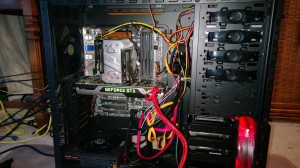
Back in March, Ben Murphy and I had the pleasure of speaking at the NVIDIA GPU Tech Conference in San Jose about best practices for the implementation of virtual GPU loads with virtual desktops and apps. Since then, I had the pleasure of speaking to numerous customers, partners, and analysts about the power of NVIDIA GRID and Lakeside SysTrack.
At Lakeside, we incorporated a number of NVIDIA APIs into the SysTrack product to allow us to monitor physical (and virtual) GPUs. By capturing granular utilization data, we allow customers and partners to model the observed GPU usage into appropriate vGPU profiles in a virtual world. Many customers who have adopted virtual desktop and applications have been reluctant to do so with graphically intensive workloads.
The introduction of NVIDIA GRID and the K1 and K2 boards are changing that rational though – corporations can now easily virtualize even the most intensive graphical use cases – and therefore reap the benefits of protecting their intellectual property in the datacenter – while still presenting a full or fractional GPU to that user. (if you have any doubts about what’s possible – try it for yourself at http://nvidia.com/tryGRID – it’ll blow you away!)
Of course, as we’re implementing this technology in our product, I had to test it myself. With a fresh (and slightly more powerful) GeForce card now in my arsenal (purely for professional testing and evaluation purposes, of course – thank you, NVIDIA!), I ventured out to put it into my system (which also serves as my primary work computer in my home office) and give it a spin.
Not so fast – I realized that the card and its physical profile would not fit into my 7 year old Mid-ATX tower case, so I had to order an appropriate power supply and full ATX case. Here’s a picture of the work in progress:

After 2 hours of open heart surgery and tons of parts in my living room floor, the deed was done and the GeForce card safely installed in the bigger case along with the rest of stuff that makes up a computer.
Next, I ran a quick test, got some food, and then took advantage of being home alone while my wife was visiting her former college roommate a couple of hundred miles away. The graph below shows the key metrics collected by SysTrack over the rest of the night. It didn’t take long to find a suitable app that would tax the GPU close to its limit 🙂
All the gaming fun aside, there is a professional angle to this:
When deciding whether or not to virtualize a graphically intensive use case IT architects must decide what virtual desktop spec and what virtual GPU spec to provide to each user.
SysTrack for virtual GPU environments
SysTrack is the only solution in the industry today that collects and analyzes pertinent data from existing physical desktop systems:
- All applications running on the system along with their resource consumption across compute, memory, storage, graphical protocols etc.
- Time correlated information across a large user base to determine concurrency, potential boot storms, and peak utilization
- Correlation of existing GPU utilization in relation to their relative capacity and mapping that usage to the vGPU profiles available with NVIDIA GRID.
- Industry-proven and award winning virtual machine planner technology to design VMware, Citrix, and Microsoft virtualization scenarios.
Assessing and designing a virtual desktop solution for professional graphical use cases is just the beginning of the fun, though. SysTrack provides all the in-depth data collection, tools, visualizers, dashboards etc. to equip organizations with the best ongoing monitoring and management tools that enable them to provide the best end-user experience.
Curious? Contact us or send us a note with your questions and comments!
Florian Becker
@florianbecker
Subscribe to the Lakeside Newsletter
Receive platform tips, release updates, news and more




